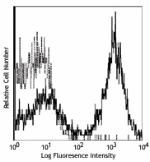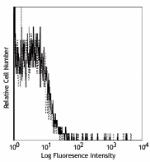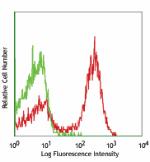- Clone
- 10-3.6 (See other available formats)
- Regulatory Status
- RUO
- Other Names
- MHC class II
- Isotype
- Mouse (CWB) IgG2a, κ
- Ave. Rating
- Submit a Review
- Product Citations
- publications

-

C3H/He mouse splenocytes were stained with anti-mouse CD19 (clone 1D3/CD19) APC and anti-mouse I-Ak (Aβk) (clone 10-3.6) Brilliant Violet 510™ (left) or mouse IgG2a, κ Brilliant Violet 510™ isotype control (right).
| Cat # | Size | Price | Quantity Check Availability | Save | ||
|---|---|---|---|---|---|---|
| 109915 | 50 µg | 216€ | ||||
This product is eligible for a 40% discount! Purchase two or more BV510, BV570, BV605, or BV650 products in any combination to qualify. Exclusions apply. Visit our webpage to view full promotion details or to contact your local BioLegend representative for a quote.
The 10-3.6 antibody reacts with the β chain of the I-Ak MHC class II alloantigen. This class II molecule is expressed on antigen presenting cells (including B cells) and a subset of T cells from H-2k bearing mice and involved in antigen presentation to T cells expressing CD3/TCR and CD4 proteins. The 10-3.6 antibody cross-reacts with I-Af,r,s antigens and I-Ag7 of NOD mice; it does not react with other haplotypes (e.g., b, d, p, q).
Product DetailsProduct Details
- Verified Reactivity
- Mouse
- Antibody Type
- Monoclonal
- Host Species
- Mouse
- Immunogen
- C3H mouse splenocytes
- Formulation
- Phosphate-buffered solution, pH 7.2, containing 0.09% sodium azide and BSA (origin USA)
- Preparation
- The antibody was purified by affinity chromatography and conjugated with Brilliant Violet 510™ under optimal conditions.
- Concentration
- 0.2 mg/mL
- Storage & Handling
- The antibody solution should be stored undiluted between 2°C and 8°C, and protected from prolonged exposure to light. Do not freeze.
- Application
-
FC - Quality tested
- Recommended Usage
-
Each lot of this antibody is quality control tested by immunofluorescent staining with flow cytometric analysis. For flow cytometric staining, the suggested use of this reagent is ≤ 0.5 µg per million cells in 100 µL volume. It is recommended that the reagent be titrated for optimal performance for each application.
Brilliant Violet 510™ excites at 405 nm and emits at 510 nm. The bandpass filter 510/50 nm is recommended for detection, although filter optimization may be required depending on other fluorophores used. Be sure to verify that your cytometer configuration and software setup are appropriate for detecting this channel. Refer to your instrument manual or manufacturer for support. Brilliant Violet 510™ is a trademark of Sirigen Group Ltd.
Learn more about Brilliant Violet™.
This product is subject to proprietary rights of Sirigen Inc. and is made and sold under license from Sirigen Inc. The purchase of this product conveys to the buyer a non-transferable right to use the purchased product for research purposes only. This product may not be resold or incorporated in any manner into another product for resale. Any use for therapeutics or diagnostics is strictly prohibited. This product is covered by U.S. Patent(s), pending patent applications and foreign equivalents. - Excitation Laser
-
Violet Laser (405 nm)
- Application Notes
-
Additional reported applications (for the relevant formats) include immunoprecipitation1,2, protection against autoimmune IDDM3, in vitro blocking of antigen-specific MHC-restricted responses and in vivo inhibition of lymphoma growth4, and immunohistochemical staining5 of acetone-fixed frozen sections.
This clone does not cross react with other haplotypes (e.g. b, d, p, q). - Application References
-
- Landais D, et al. 1986. J. Immunol. 137:3002. (IP)
- Kupinski JM, et al. 1983. J. Immunol. 130:2277. (IP)
- Kappler JW, et al. 1981. J. Exp. Med. 153:1198.
- Alisauskas RM, et al. 1986. Immunopharmacology 12:1.
- Reis e Sousa and Germain 1999. J. Immunol. 162:6652. (IHC)
- Yui MA, et al. 2010. J. Immunol. 185:284. PubMed
- Gaudreau S, et al. 2007. J. Immunol. 179:3638. (FC)
- RRID
-
AB_3662361 (BioLegend Cat. No. 109915)
Antigen Details
- Structure
- β chain of MHC class II
- Distribution
-
B cell and activated T cells, APCs of H-2b mice
- Function
- Antigen presentation
- Ligand/Receptor
- CD3/TCR, CD4
- Cell Type
- Antigen-presenting cells, B cells, T cells, Tregs
- Biology Area
- Immunology, Innate Immunity
- Molecular Family
- MHC Antigens
- Antigen References
-
1. Watts C. 1997. Ann. Rev. Immunol. 15:821.
2. Pamer E, et al. 1998. Ann. Rev. Immunol. 16:323. - Gene ID
- 14961 View all products for this Gene ID
- UniProt
- View information about I-Ak on UniProt.org
Related FAQs
Other Formats
View All I-Ak Reagents Request Custom Conjugation| Description | Clone | Applications |
|---|---|---|
| FITC anti-mouse I-Ak (Aβk) | 10-3.6 | FC |
| PE anti-mouse I-Ak (Aβk) | 10-3.6 | FC |
| Purified anti-mouse I-Ak (Aβk) | 10-3.6 | FC,IHC-F,IP |
| Brilliant Violet 421™ anti-mouse I-Ak (Aβk) | 10-3.6 | FC |
| Brilliant Violet 510™ anti-mouse I-Ak (Aβk) | 10-3.6 | FC |
| Brilliant Violet 650™ anti-mouse I-Ak (Aβk) | 10-3.6 | FC |
Compare Data Across All Formats
This data display is provided for general comparisons between formats.
Your actual data may vary due to variations in samples, target cells, instruments and their settings, staining conditions, and other factors.
If you need assistance with selecting the best format contact our expert technical support team.
-
FITC anti-mouse I-Ak (Aβk)

C3H/He mouse splenocytes stained 10-3.6 FITC 
C57BL/6 mouse splenocytes stained 10-3.6 FITC -
PE anti-mouse I-Ak (Aβk)

C3H/He mouse splenocytes stained with 10-3.6 PE 
BALB/c mouse splenocytes stained with 10-3.6 biotin and dete... -
Purified anti-mouse I-Ak (Aβk)

C3H mouse splenocytes stained with 10-3.6 purified, followed... -
Brilliant Violet 421™ anti-mouse I-Ak (Aβk)

C3H/He mouse splenocytes were stained with anti-mouse CD19 (... -
Brilliant Violet 510™ anti-mouse I-Ak (Aβk)

C3H/He mouse splenocytes were stained with anti-mouse CD19 (... -
Brilliant Violet 650™ anti-mouse I-Ak (Aβk)

C3H/He mouse splenocytes were stained with anti-mouse CD19 (...

 Login / Register
Login / Register 













Follow Us